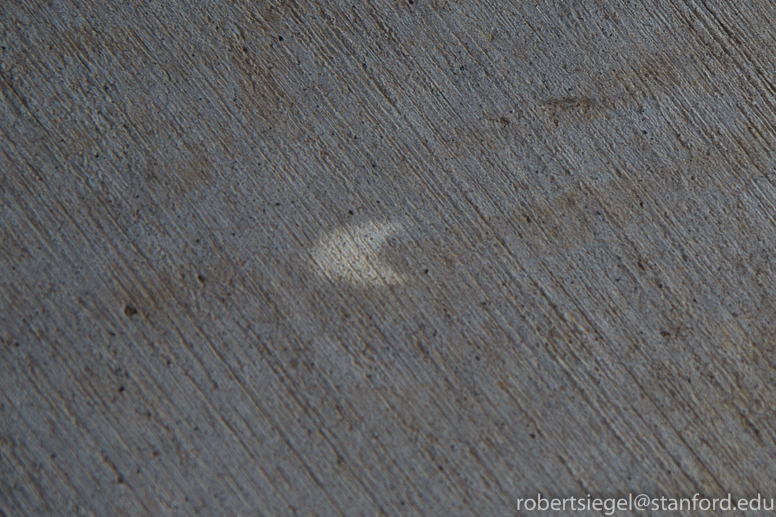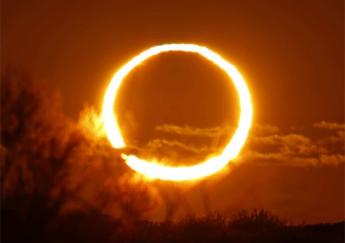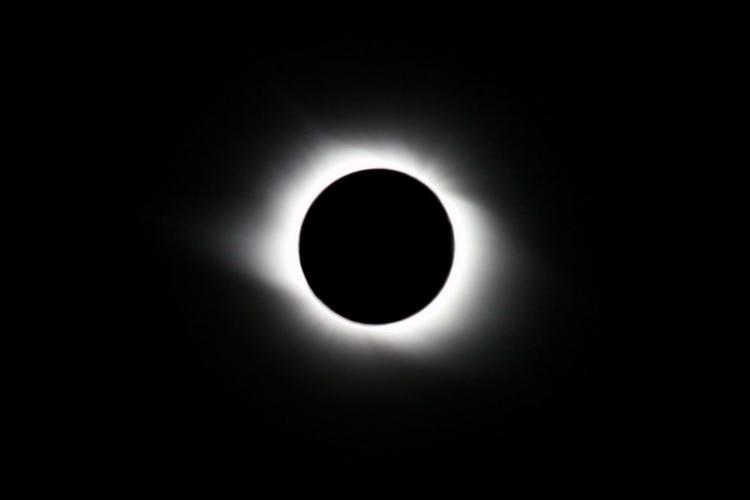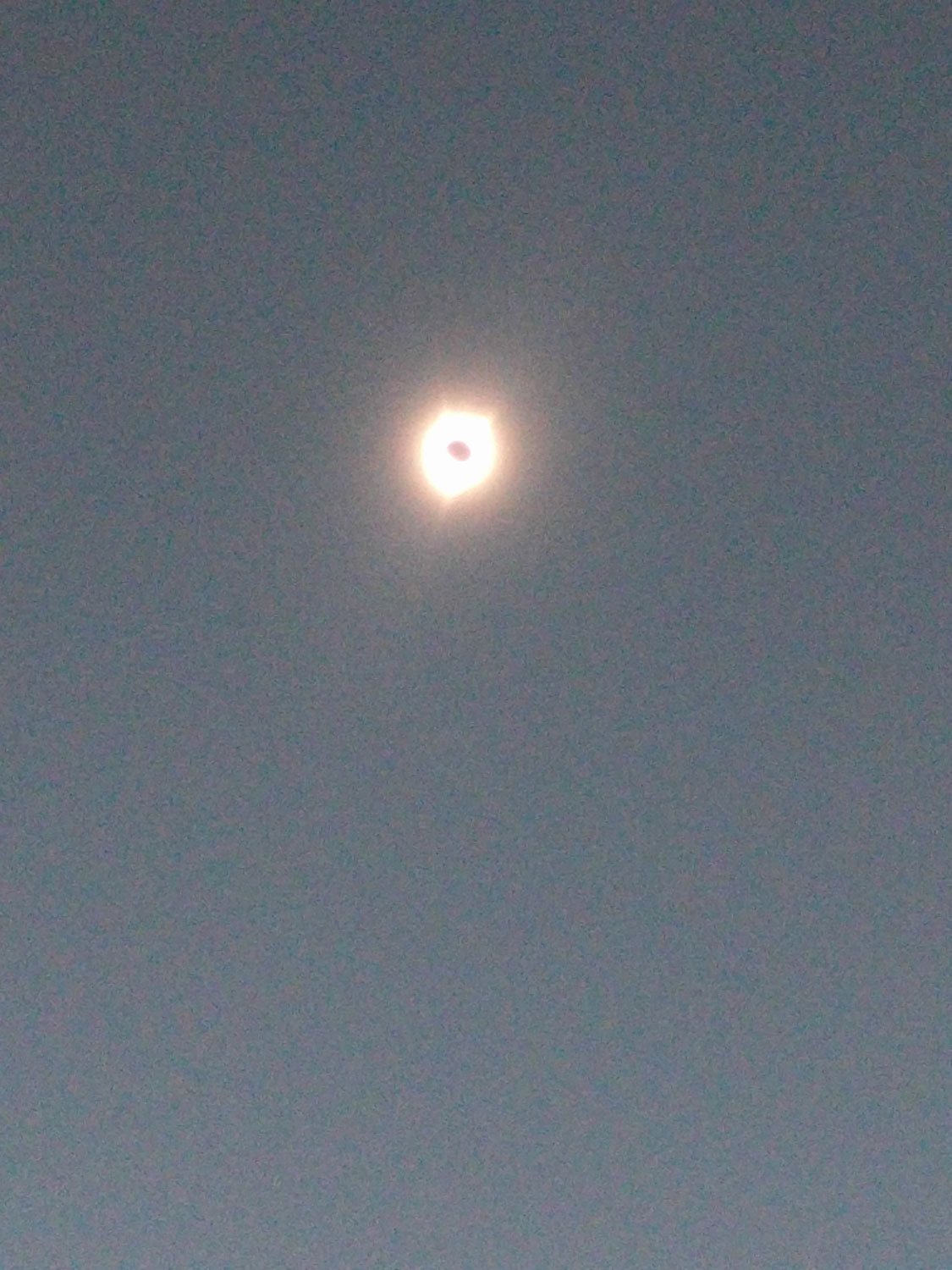As you might possibly be aware, yesterday, on August 21, 2017, a total solar eclipse swept sea-to-shining-sea across America. The media called it a “once in a lifetime” event.
To which I said, “Pfft. Whatevs, media. I’ve seen a solar eclipse before.”
I was living in upstate New York at the time. It was May 10, 1994. Ace of Base was tearing up the charts with “The Sign.” At the movies, we were falling in love with a 44-year-old Martin Short playing a 10-year-old problem child in the beloved and not-at-all-nightmarish family comedy Clifford. And I was a senior in high school.

As everyone knows, looking directly at the sun, even during an eclipse, can cause permanent blindness. So some science nerds from the school’s Science Nerd Club had set up a big pinhole camera viewer thing to project an image of the eclipse onto the sidewalk. We didn’t have cameras back in the ’90s, but it looked a little something like this modern photo by Stanford’s Robert Siegel.

If you can’t fully appreciate what you’re looking at here, it’s a small circle of sunlight with another circle of not-sunlight slowly creeping over it. I remember it also got dark enough for the school’s light-sensing streetlights to briefly turn themselves on.
That’s right. Circles AND streetlights. IS YOUR MIND BLOWN YET?
High-school Marcus was so incredibly captivated by the majesty and spectacle of the 1994 eclipse that I remember choosing to sneak out and get a Domino’s Pizza instead of waiting for the thrilling conclusion of one circle completely moving past another circle.
Jump forward twenty-three years. Child Marcus has grown up into Man Child Marcus. I now live near Portland, Oregon, where buzz about the “Great American Eclipse” had been building for months, since the path of totality was to cut right through the center of the state.
As eclipse fever seized the Metro area, a friend of mine excitedly mentioned that she had a friend who traveled the globe chasing solar eclipses, experiencing them wherever and whenever they happened. I shrugged it off, wondering how much fun that could possibly be.
“I’ve seen an eclipse,” I said dismissively. “It was cool to see once, but is it really worth all that travel? It’s like, ‘Oooh, it got dark, then it got not dark anymore. That was totally worth a fifteen-hour flight to Bangladesh.'”
The sense of giddy wonder completely evaporated from my friend’s face. She gave me a crestfallen little nod and admitted that she hadn’t thought of it like that. I felt like a child had asked me if Santa Claus was real and I had said, “Oh, yeah. Santa Claus is ABSOLUTELY real. I saw him when I was a kid. And he touched my no-no place.”
But the rest of the west coast did not share my wet blanket. The Oregon Department of Transportation (ODOT) expected the eclipse to create the “biggest traffic event in Oregon history.” Every habitable space under the path of totality had been pre-booked years in advance, and emergency management officials estimated more than one million people would be flocking in from out of state.
They anticipated delays that would last for “hours and hours.” Cell towers were to become overloaded, causing phones to be rendered useless. They said emergency services would be immobilized by the impending “eclipse-alypse,” so be sure to have all of your prescriptions up to date and maybe try not to set your house on fire until mid-week at the earliest.
To show how serious they were, ODOT put their warning in the form of a poem.
If you wait to arrive
You’ll be late on the drive
And miss the celestial lights.If you hurry to leave
You’ll surely feel peeved
Stick around and see Oregon’s sights.
But Amanda and I aren’t the type to be scared by traffic, or experts, or AABCCB rhyme schemes. The center of the path of totality was a mere fifty-four miles from our house. Despite my lackluster experience in high school, I was all in for the adventure.
Taking heed of ODOTs dire warnings, before we left we stocked the car like my grandparents stocked their cold-war bomb shelter.

Pictured here is our Eclipse Road Trip Emergency Kit, containing:
– Two sun hats
– Three gallons of drinking water
– Two additional bottles of drinking water
– Three types of sun block
– Four eclipse viewers
– Three varieties of Pringles
– Three bottles of Gatorade
– Two cans of Coca-Cola
– A bottle of Advil
– Four bananas
– Five protein bars
– Four cheese sticks
– One tub of cubed watermelon
– Two pillows
– Two books
– A roll of paper towels
– A roll of toilet paper
– A backpack containing a change of clothes, toothbrushes, and toothpaste
With the car gassed up and prepped for an eight-year-old’s slumber party, we got up at 3 AM and attacked the night.
McMinnville, Oregon was the closest city that would experience totality, but only for about 30 seconds. Our plan was to try to battle traffic that far, then once we got there re-evaluate and see if we had time to press deeper under the moon’s shadow for a longer duration of totality.
About a half-hour later we were in downtown McMinnville. Despite the preemptive horror stories, the traffic Armageddon had failed to materialize. So we didn’t even stop. We just kept on, keepin’ on, rolling south with no resistance on the road toward maximum eclipsitude.
At about T-minus five hours we reached the center of the impending path of totality in Dallas, Oregon. It was only about 5:30 in the morning, but the streets were already dotted with cars sporting Washington, California, and British Columbia license plates, all full of families snoozing after their long-haul drives.
As luck would have it, we parked right next to a restaurant that was open early for Eclipse Day. Tater’s Cafe was packed with a pre-dawn crowd of totality seekers excited for the sun to come up so that it could go away again.
After breakfast, we headed to downtown Dallas, where all the streets had been closed for their three-day-long eclipse party. With two hours until totality, we settled in with our lawn chairs among the crippling throngs of people who absolutely failed to show up.
While a band played on a giant grandstand in the street, the crowd in Dallas sat in rapt attention, facing away from the stage and staring at the sun.
At this point the whole thing started to feel very familiar. It was high school all over again. Instead of a pinhole camera I had a pair of dumb cardboard eclipse viewing glasses, but the show was exactly the same.
One circle slowly overtaking another circle.

To keep myself entertained I decided to show all the kids back home what the eclipse looked like through the miracle of Instagram snark.
After about an hour of red hot circle-on-circle action, the moon had finally just about covered the sun. The emcee of the event got on the microphone and reminded us that once the sun had reached complete totality it would be safe to view it without protection.
I thought, “Wow. So when the sun is COMPLETELY COVERED we can look at it? Neat. I’ve seen that. It’s called darkness.”
But I sat there and watched with a certain New Year’s Eve ball-drop excitement as the flat yellow toenail of sun in my viewer grew smaller and smaller and finally winked out into blackness.
I lowered my viewer and my heart seized in my chest.
At this point I need to mention something that I didn’t realize until just now when I sat down to write this and did some actual goddamn research. That eclipse I saw in 1994? It wasn’t a “total solar eclipse.” It was an “annular solar eclipse.”

In an annular eclipse, the celestial bodies are positioned relative to each other in a way that the moon does not completely block the sun. At maximum coverage it leaves a “ring of fire” still visible which cannot be viewed by the naked eye. Your pinhole camera image looks like that thing in the VHS tape from The Ring. Whoop-de-do.

A total solar eclipse is… different.
The totality is simultaneously the most breathtakingly beautiful and the most pants-crappingly terrifying thing I’ve ever seen.
When I put down my viewer the sun was gone. And in its place was a hole in the sky blacker than anything I could imagine. Blacker than ink. Blacker than the blacks on your 4K UHD TV. Blacker than Michael Myers’ eyes. Just a complete, sucking, soul-crushing absence of light.
And the blackness was surrounded by heavenly white fire.
You’ve seen pictures like this.

This picture is dog crap. Every picture I’ve found of any eclipse ever is dog crap. This looks like a Photoshop filter from 2003. It looks like a billiard ball wearing an Einstein wig. Looking at this and thinking you understand what a total eclipse looks like is like looking at this statue and thinking you understand what Lucille Ball looks like.

Part of the problem is that the totality can’t be expressed in a still image. The corona of the sun visible during an eclipse isn’t a stationary smudge of chalk on a blackboard. It’s a million dancing tendrils of pure white light against a sky of dusky blue twilight.
It’s the gauze of a ghostly bride’s wedding dress blowing on a spectral wind.
It’s a wriggling flare of unimaginable power and beauty.
Even from 93 million miles away it looks enormous and ominous. It feels too close, and at the same time, you yearn for it to come closer.
It’s impossible to describe without sounding like you’re stoned.
Even as a twenty-first-century person with a working understanding of what I was looking at, the sight of the totality knocked the breath from my lungs and paralyzed me with pure, unbridled awe. I now fully and completely understand how ancient cultures could look at these things and, collectively, as a society, crap the bed and make up a bunch of new rules to keep the gods happy.
I don’t know how long I stared at it before I started taking pictures.
I didn’t start taking pictures with a casual “social media OMG selfie” attitude. I started taking them in an irrational, adrenaline-charged panic. The logical part of my mind knew I couldn’t capture the experience with a three-generation-old cell phone camera, but some primal part of my unconscious didn’t care. The totality would last for less than two minutes. I had to save it. I had to do something to grab onto this thing so I could hold it and keep it before it disappeared again.
Here’s what I got.

That photographic sky pimple would be hilarious if it weren’t so heartbreaking. The instant the totality was over and the sun started creeping back around the moon I was split with an indescribable chasm of loss. This incredible thing that I had just barely had a chance to see was gone, and it was impossible to get it back.
I immediately regretted squandering a single second trying to photograph it. I wanted a do-over. I wanted to go back and just stare gape-mouthed for the full one minute and fifty-six seconds I had been given.
As I write this I realize the image of the totality is already shaking itself clear from the Etch-A-Sketch of my mind. I know it won’t be long before all I have left are these descriptions of what I saw. The memory will be gone, and I won’t understand why it affected me so profoundly.
Even now I don’t understand.
ODOT had prepared me for traffic. Nothing prepared me for the totality.
If a Google Image Search is to be believed, it is impossible to capture what the eclipse corona actually looks like with modern photographic equipment. In my searching, this animated computer simulation by Predictive Science, Inc. is by far the closest approximation I’ve found.

But even as the closest approximation I’ve found, seeing this prepares you to see the totality about as well as seeing Jurassic World prepares you to see a real dinosaur. As Dee Snider says, “If that’s your best, your best won’t do.”
With the eclipse over and our minds thoroughly blown, we bid goodbye to Dallas. There was moderate traffic on the way home, mostly caused by farm equipment in the road (hashtag OregonLife).
Here’s what our supplies looked like by the time we rolled into our driveway at about 4 PM.

Okay, so we may have slightly over packed. The only thing we actually ended up eating in the car was a bag of m&m’s Amanda bought at a gas station when we stopped to pee.
And then the adventure was over. We’d seen an incredible thing and that was that.
Or was it?
Fast forward to this morning when I talked to my mom and dad on Skype. They saw the eclipse from upstate New York, still in the same town where I went to high school. They saw 73% coverage. They thought it was pretty neat. They asked what I thought.
I tried to tell them what I saw and had a complete mental breakdown. A crippling wave of emotion crested over me, and I choked words through sobs as if my parents had just been run over by a truck and I needed to let them know I love them and I’m sorry for being such an butthead my whole life and I promise this time I’ll turn it around and get myself together if they just live. LIVE, DAMN YOU! LIVE!
They were polite enough to change the subject.
Right now, as I’m writing this, 30+ hours later, I’m bawling. For real, streaming tears, red-ugly-face bawling. It’s not because I’m sad I’ll forget what I saw. It’s because I was emotionally unequipped to experience it in the first place. It broke me.
That lame thing I saw in high school tricked me into a false sense of experience. The solar totality of 2017 was a shock-and-awe campaign of celestial splendor so powerfully executed it gave me PTSD. Post Totality Sobbing Disorder.
I can’t stop thinking about it.
The media said the eclipse was a “once in a lifetime” event.
I say, “See you in 2019, Argentina.”

Amazingly well written! And what an experience to see the totality of it!!
Thank you! It was a truly humbling experience. I’m glad you enjoyed my recap. 🙂
Well done, Marcus!
Thanks! 🙂
Wow. What an experience. This sounds amazing!! I’m so happy to read this because we thought it was amazing at that 73% too but doesn’t sound like it compares to the total darkness. Crickets did come out, shadows grew longer, and you didn’t need sunglasses on a cloudless 86° day, which was very strange. The day did feel special though, that’s for sure.
I thought the quality of the light turned SO WEIRD when the sun was almost covered. It looked like wearing cheap sunglasses. Like, fake darkness. Like in the movies when they shoot “day-for-night” and make it fake dark in post. Everything looked like it had been taken into Photoshop and had the contrast pulled way down.
I saw it from Vanore, TN and lugged as much photo gear I could without causing TSA to add a special cavity search while flying. I too found it pretty amazing and was glad to make the journey and share it with my family. I haven’t processed all the photos yet but here is one from when the sun started to peek out on the back side. http://davidmathre.photoshelter.com/img-show/I0000zSoDFfZ7qmU
Cool! I’m happy you guys got to see it and I’m also happy the TSA did not look in your butt.